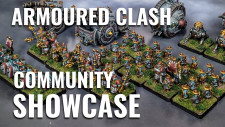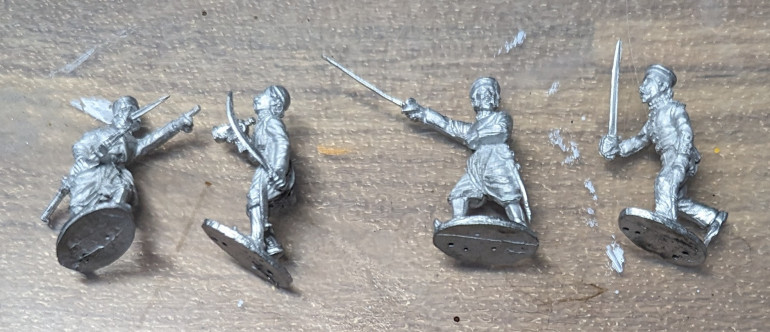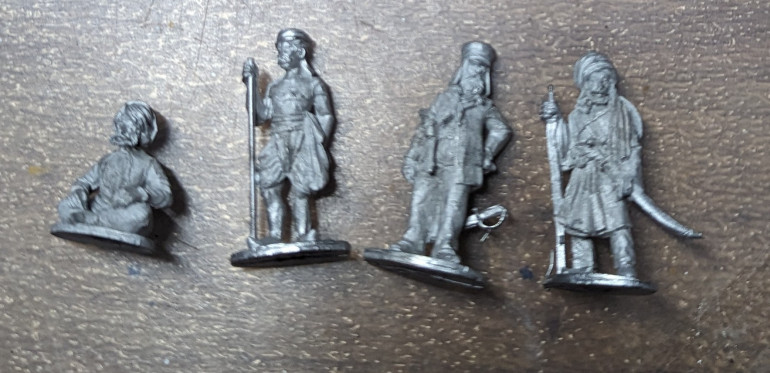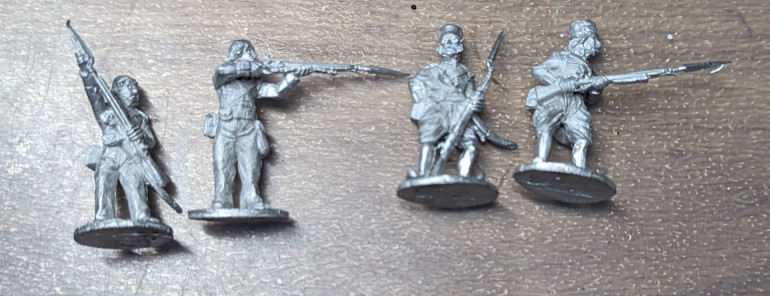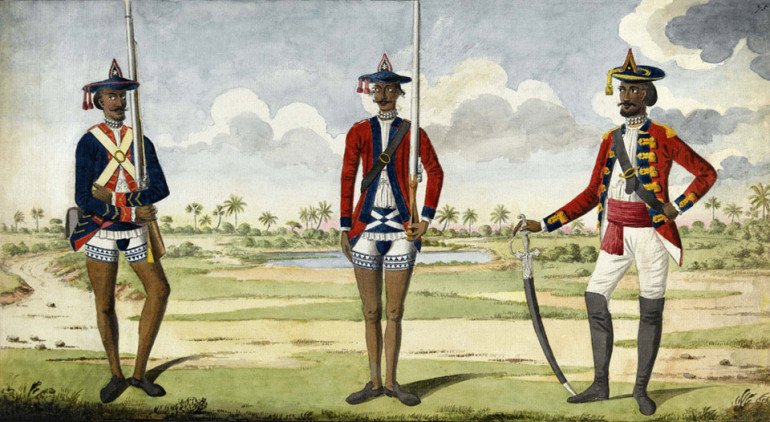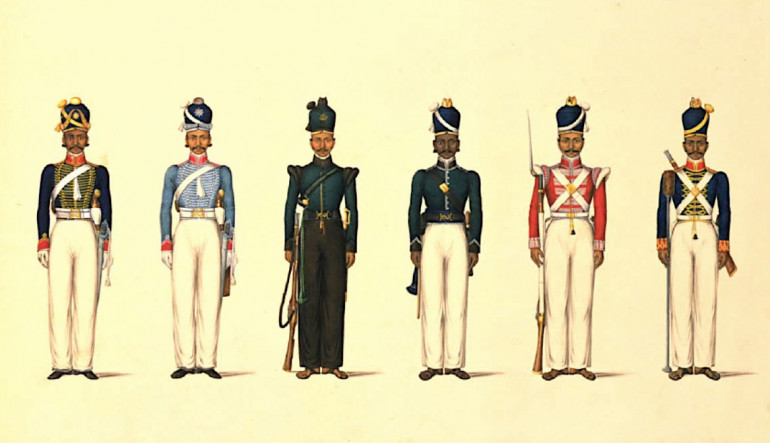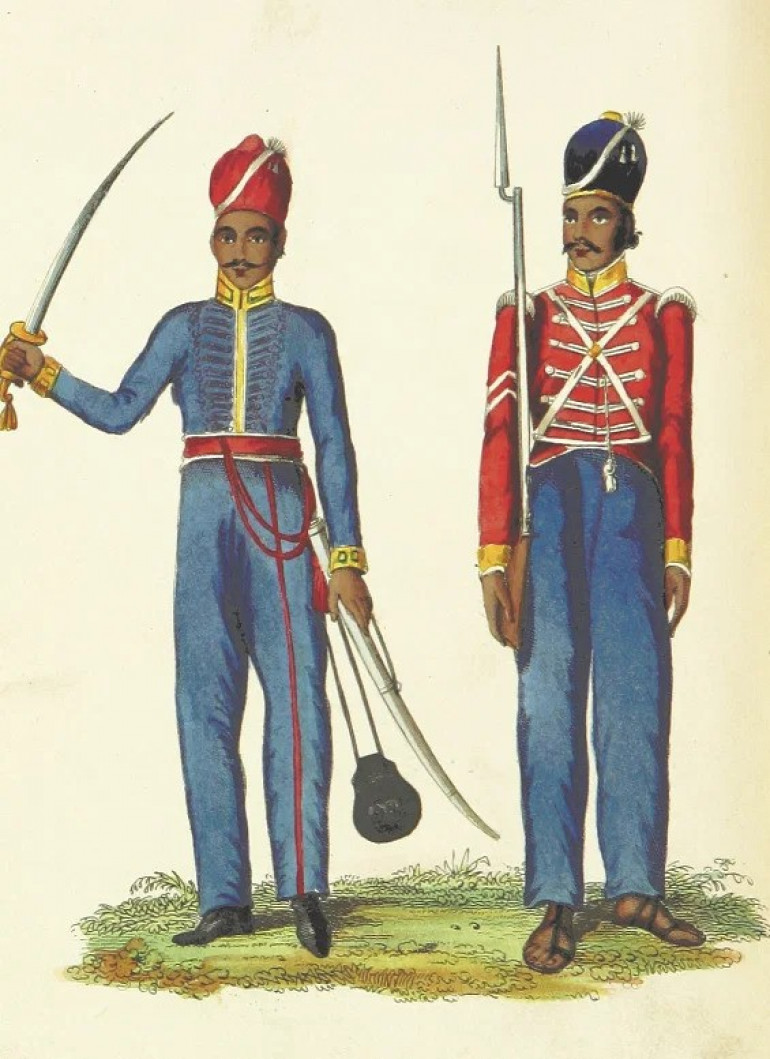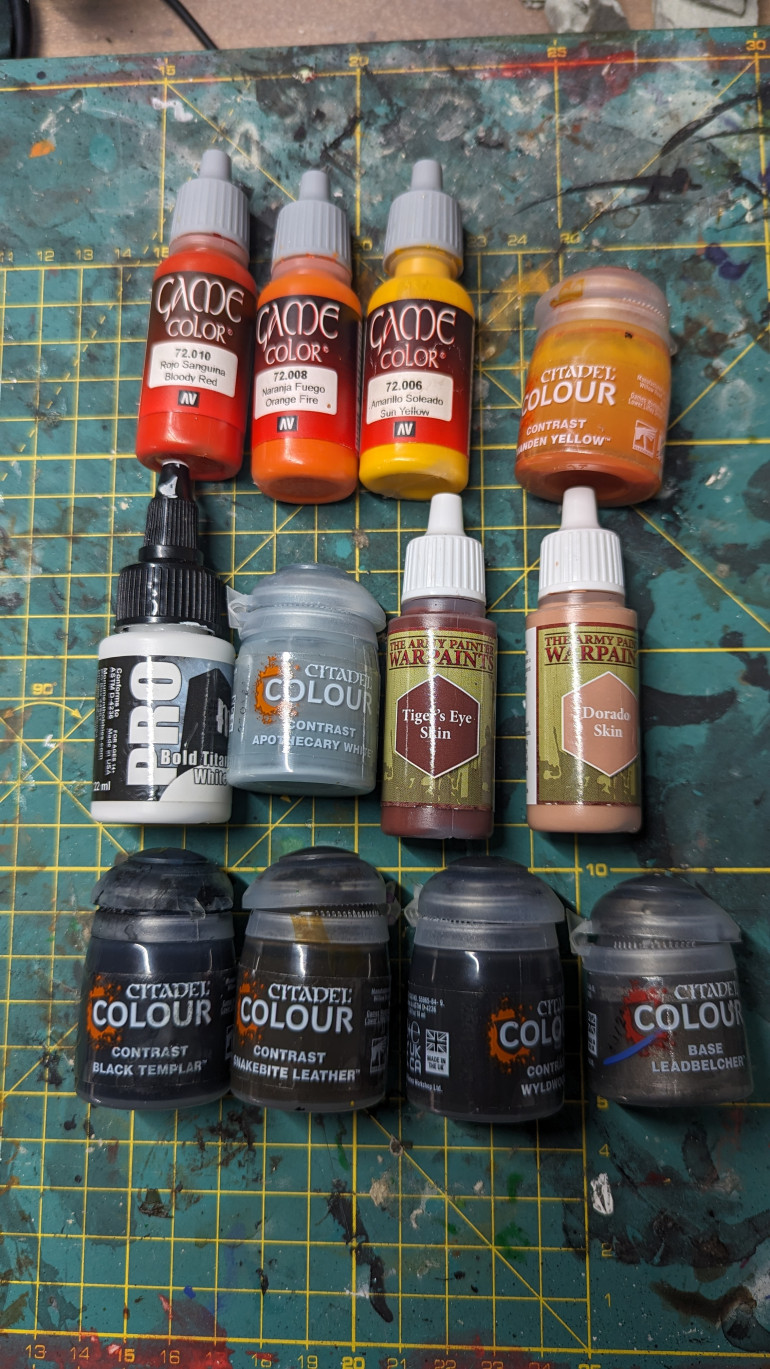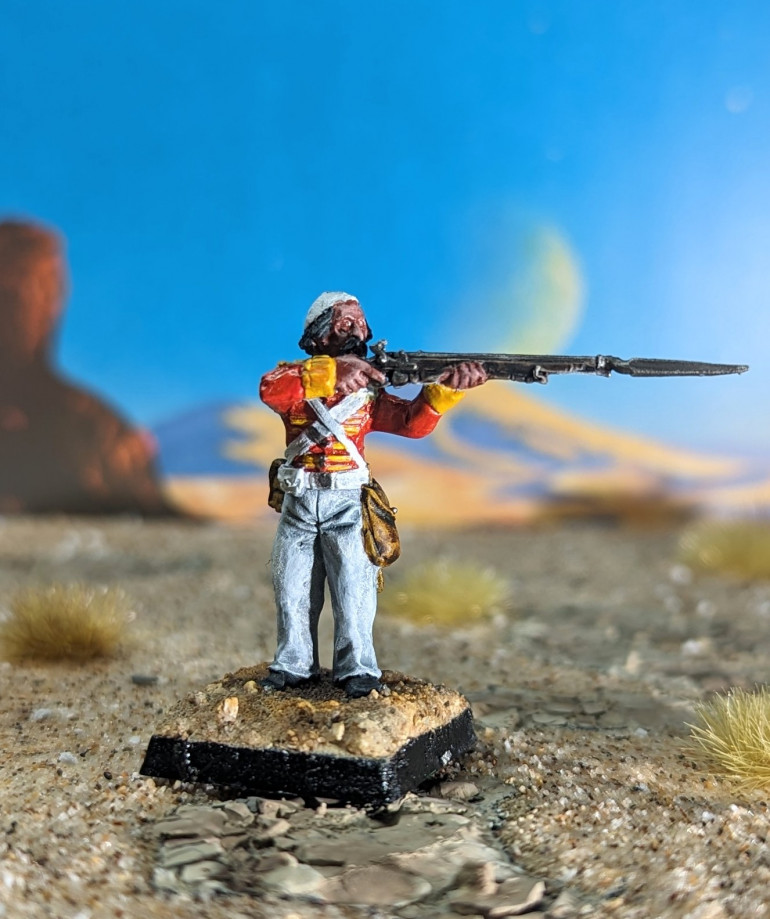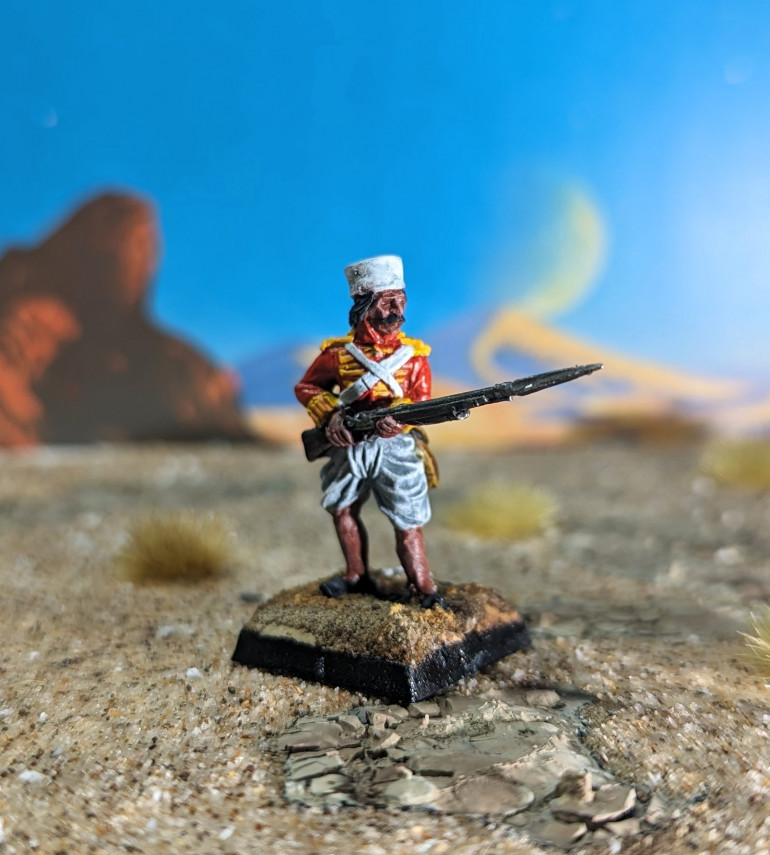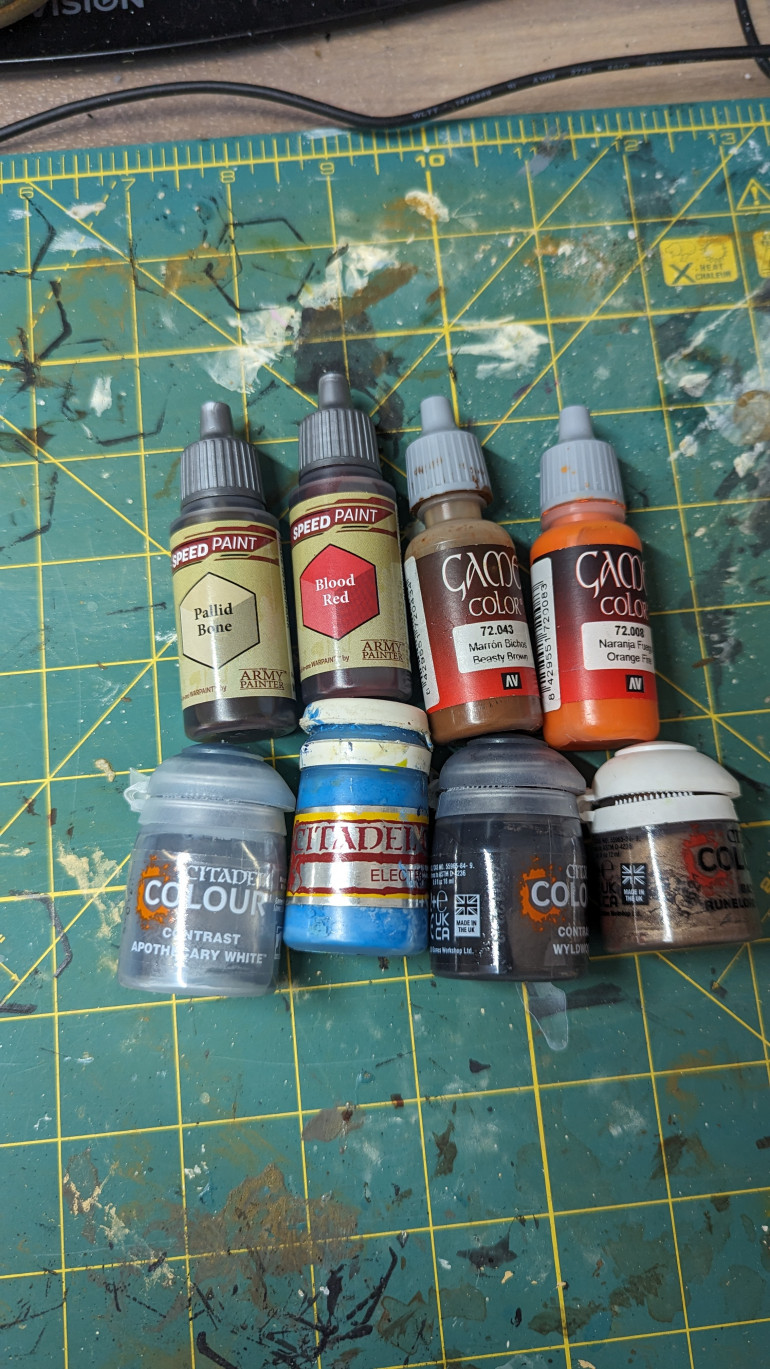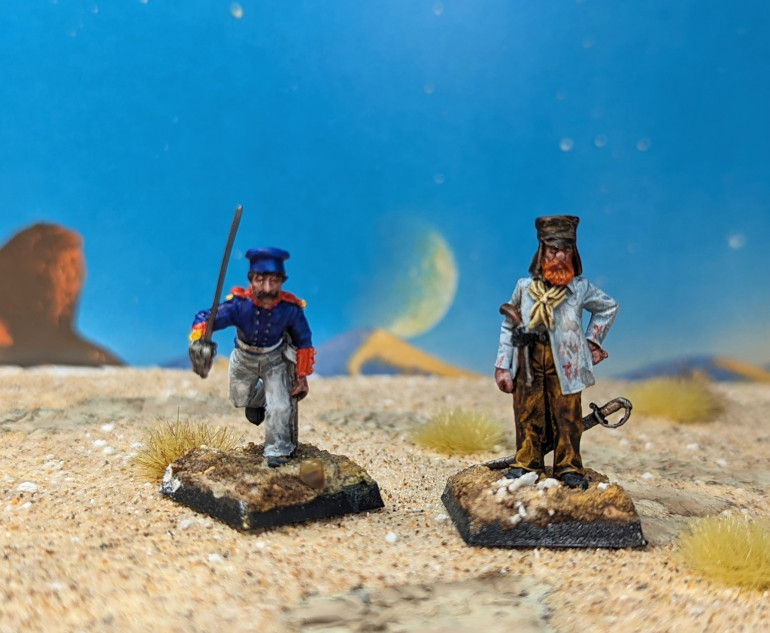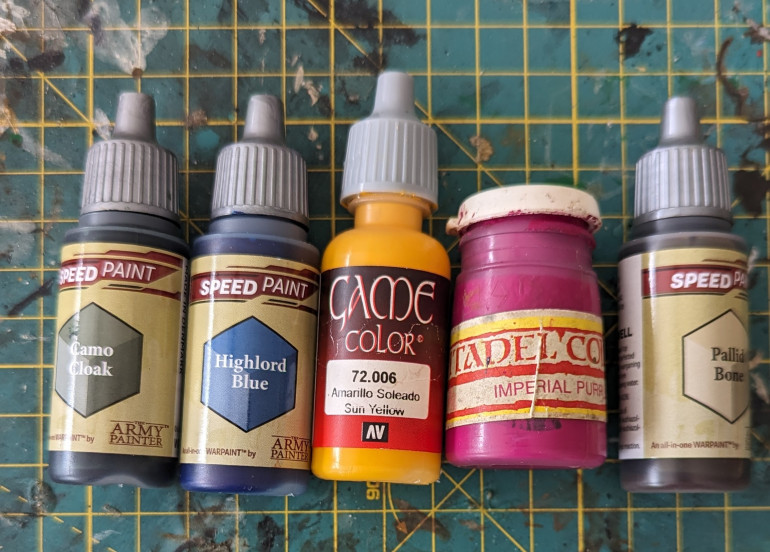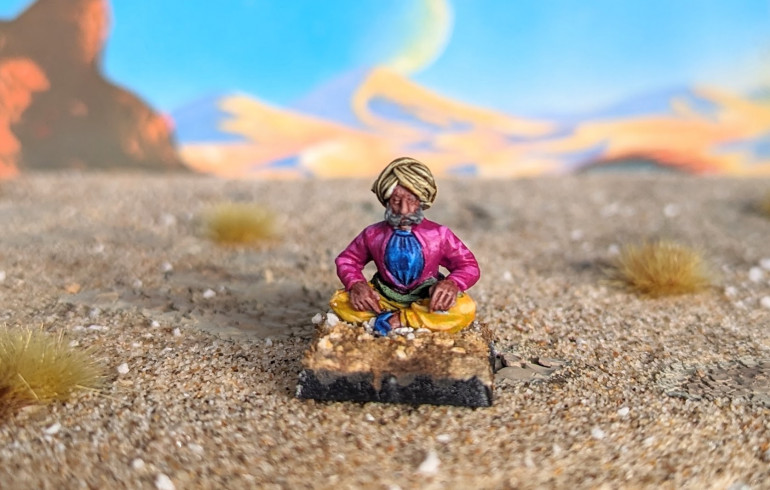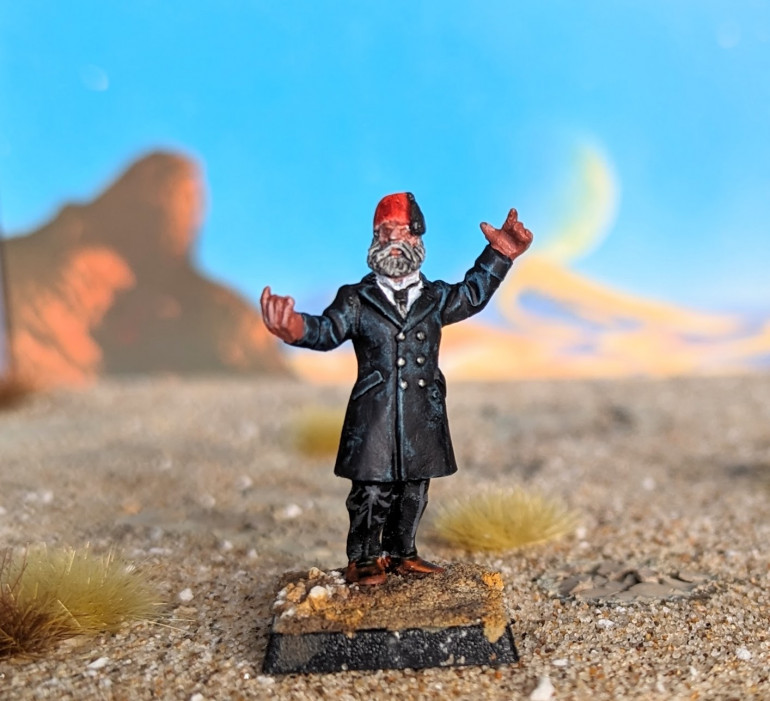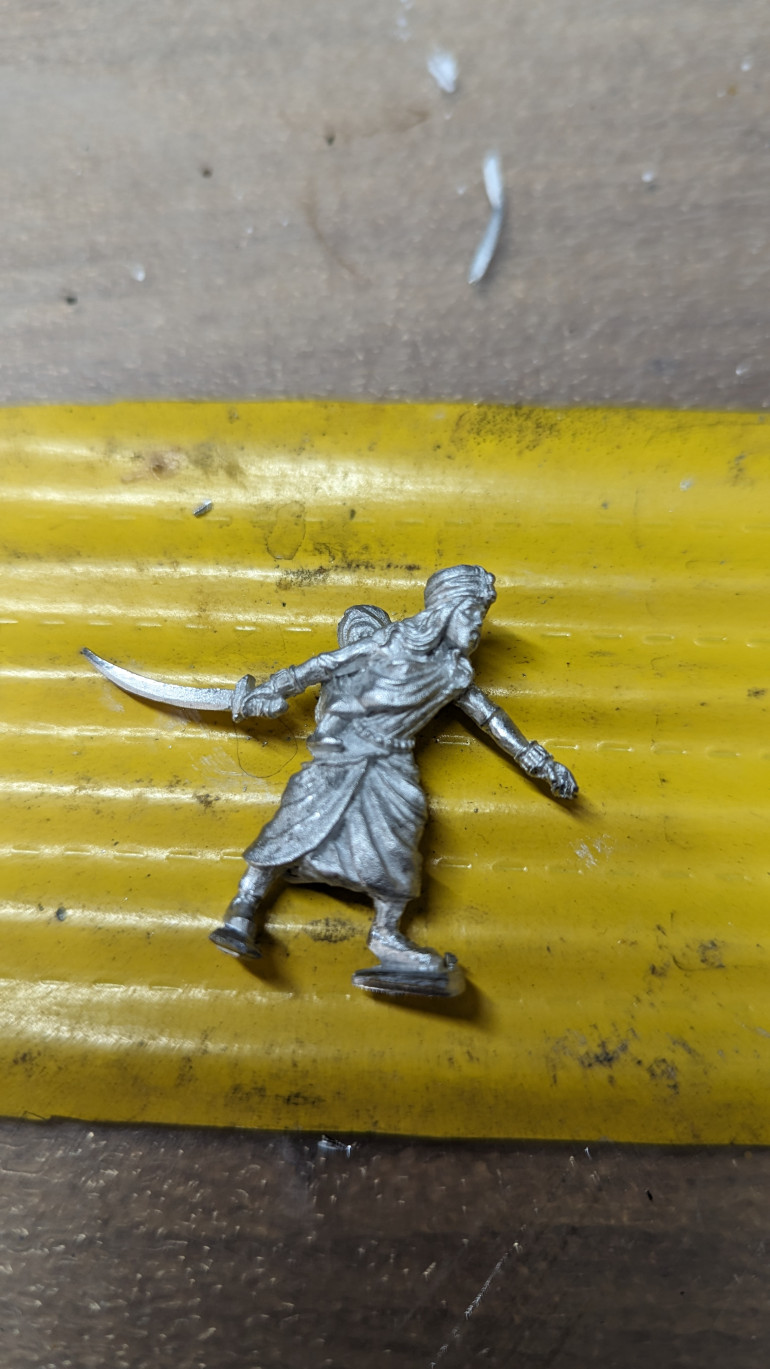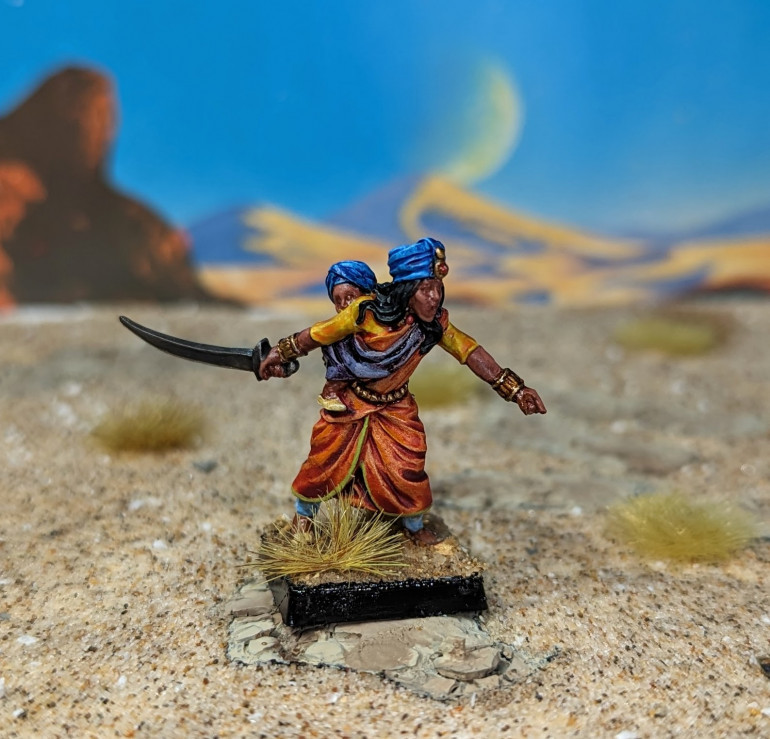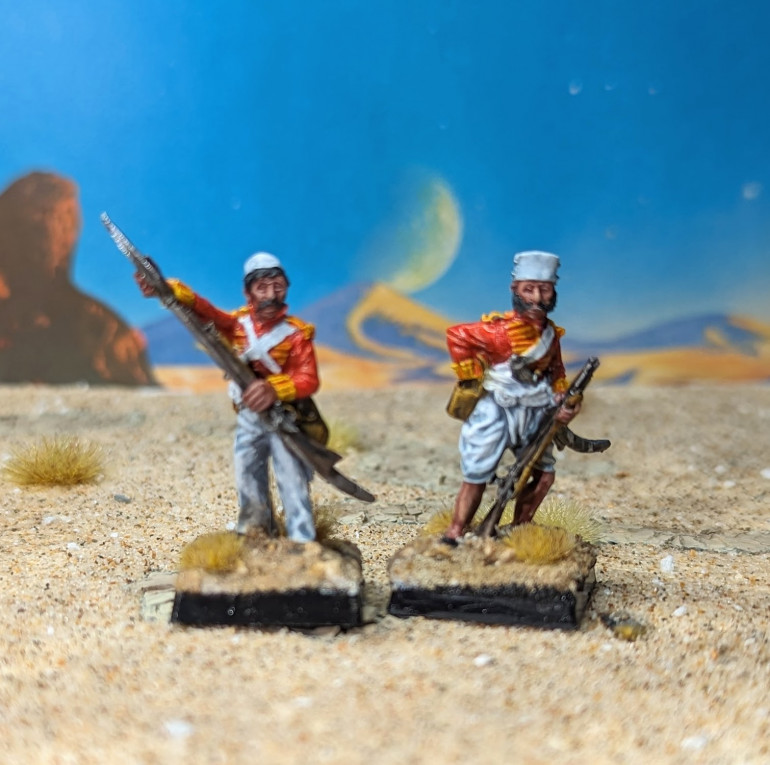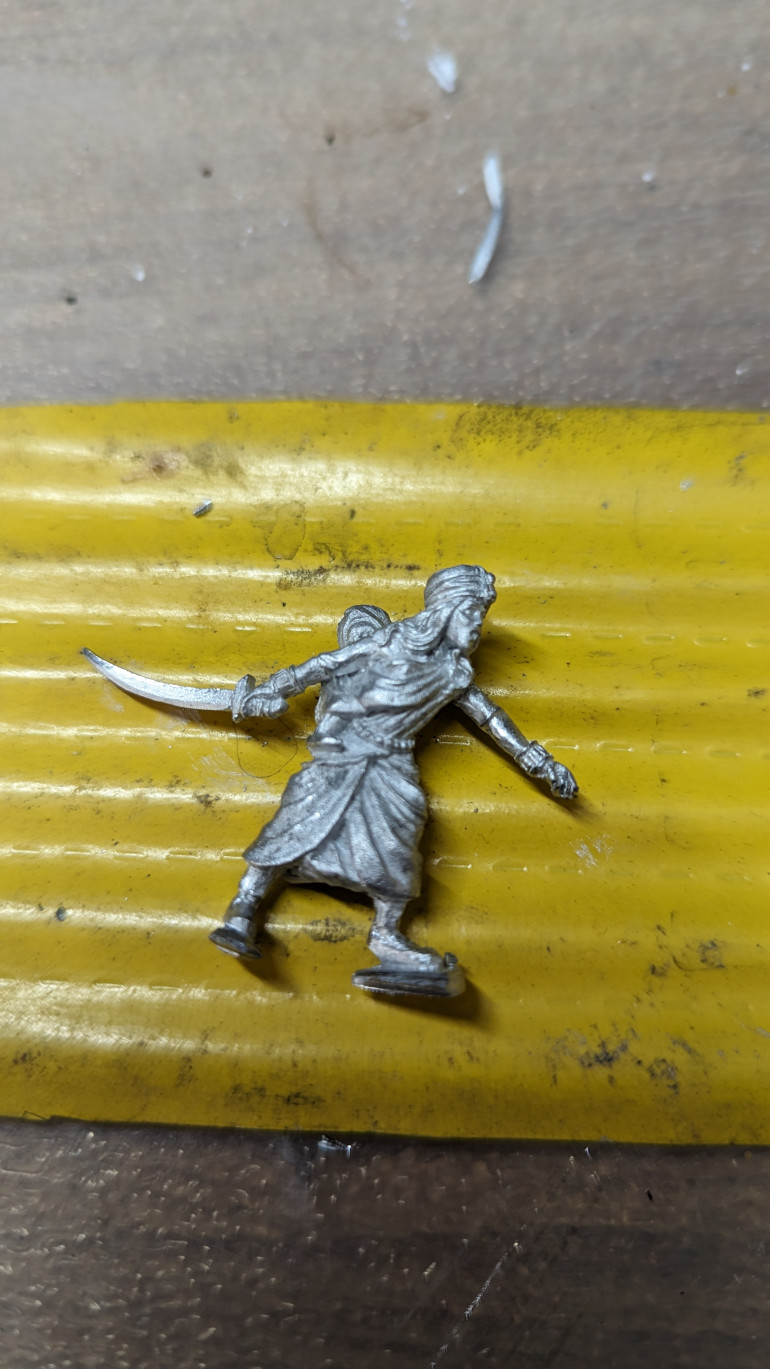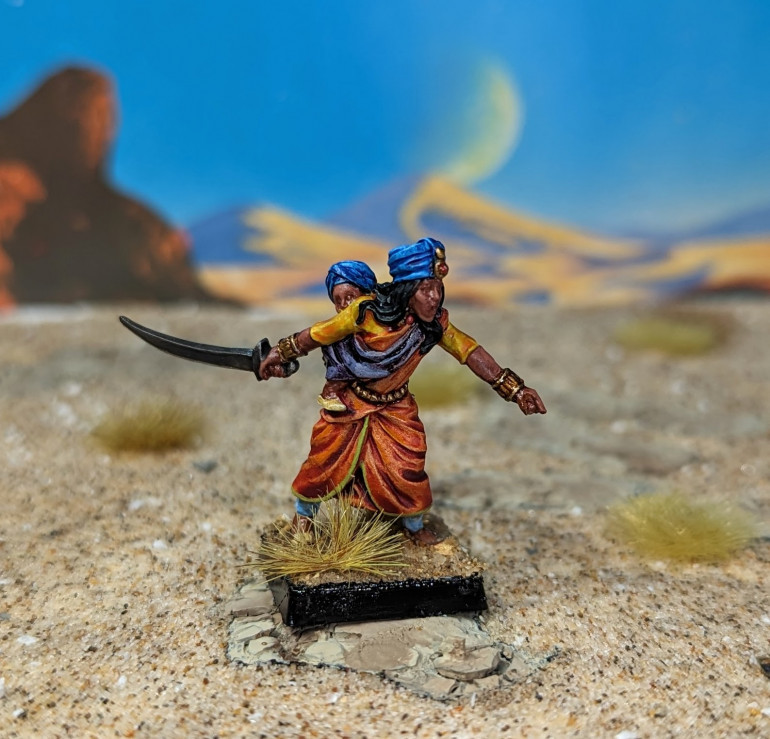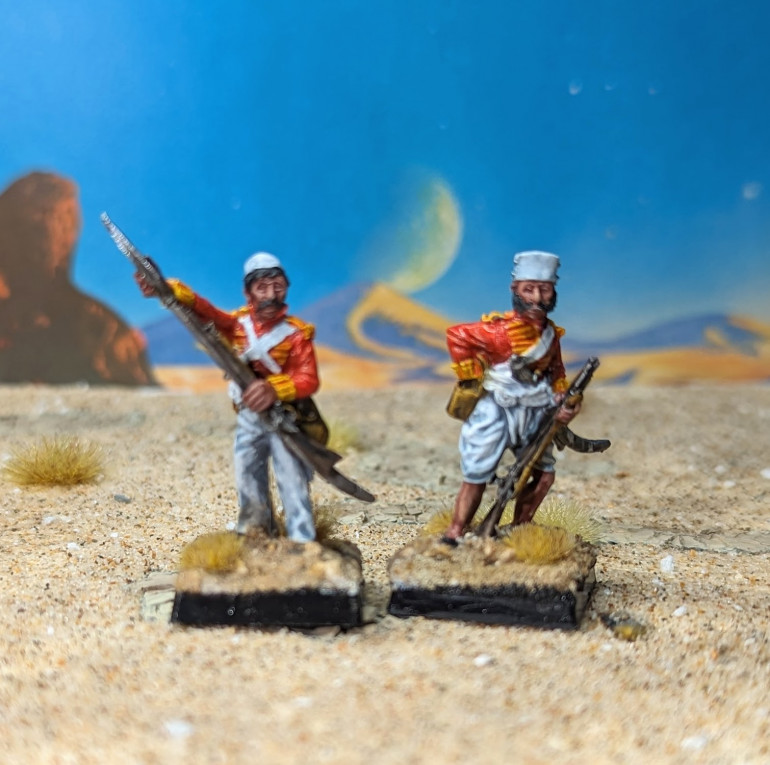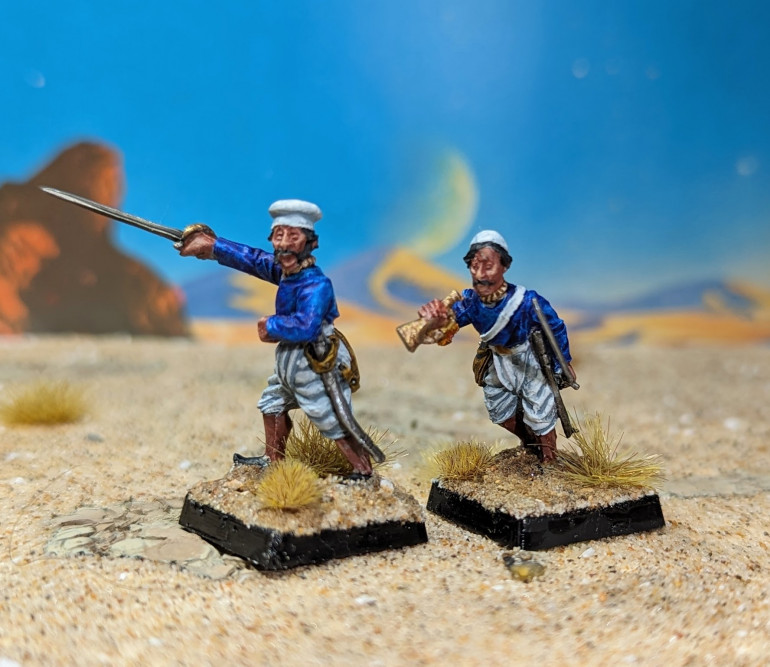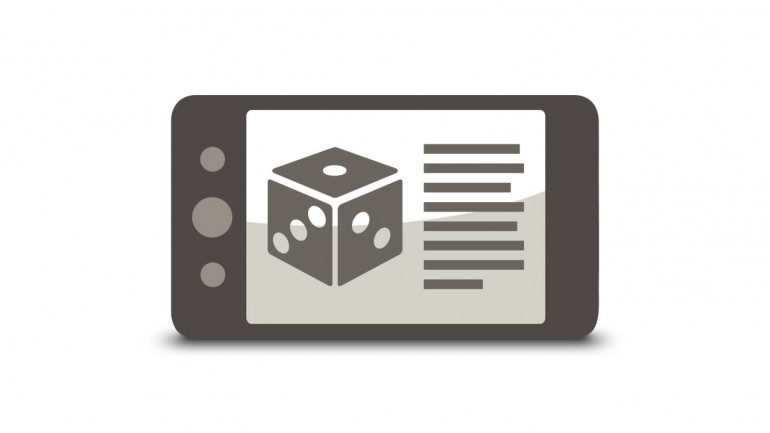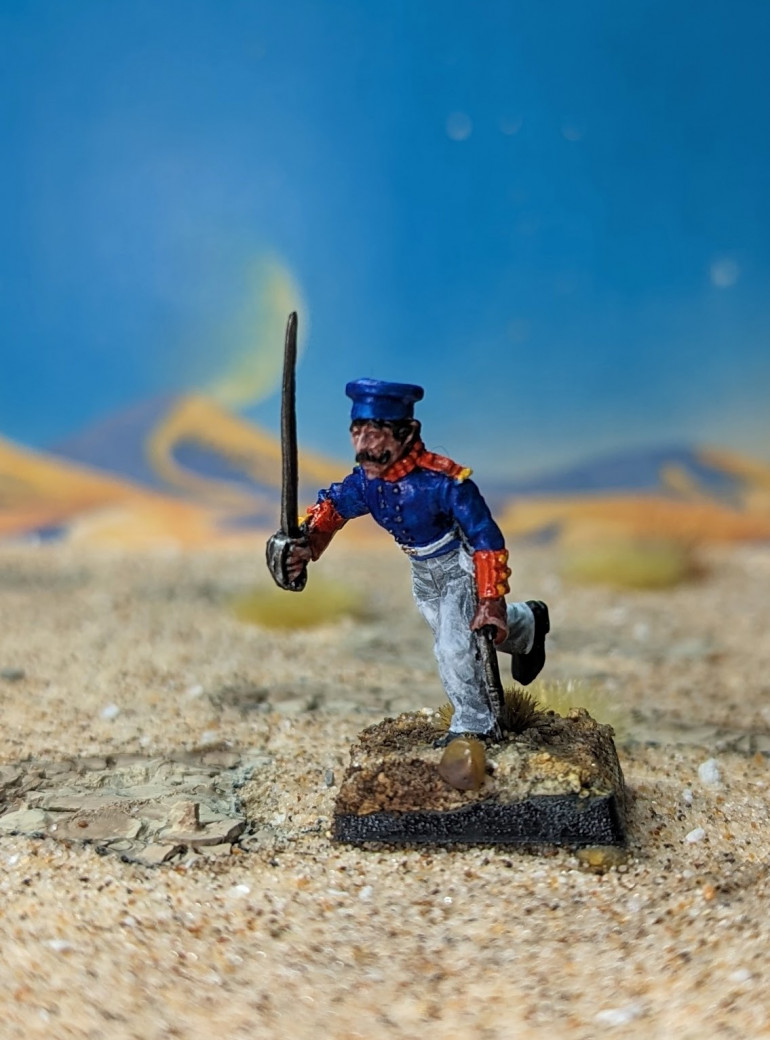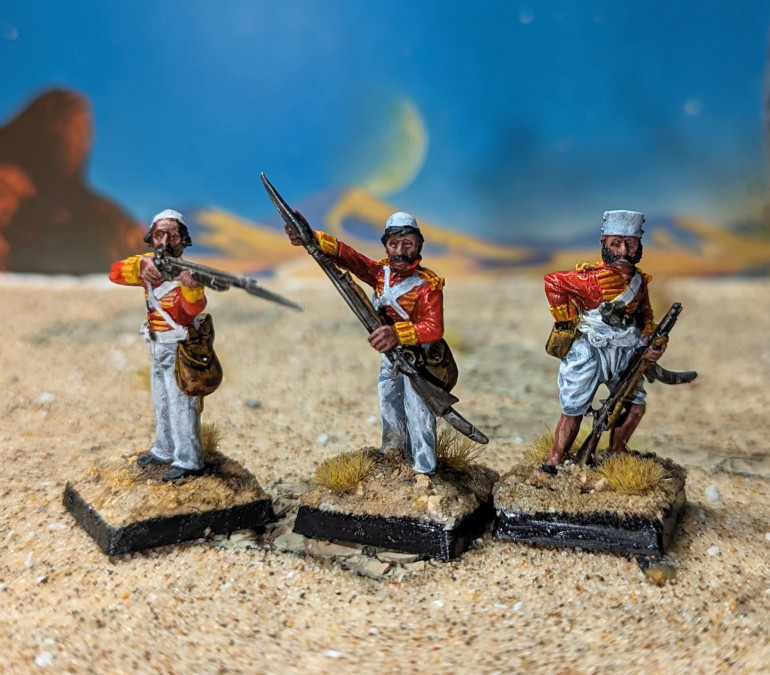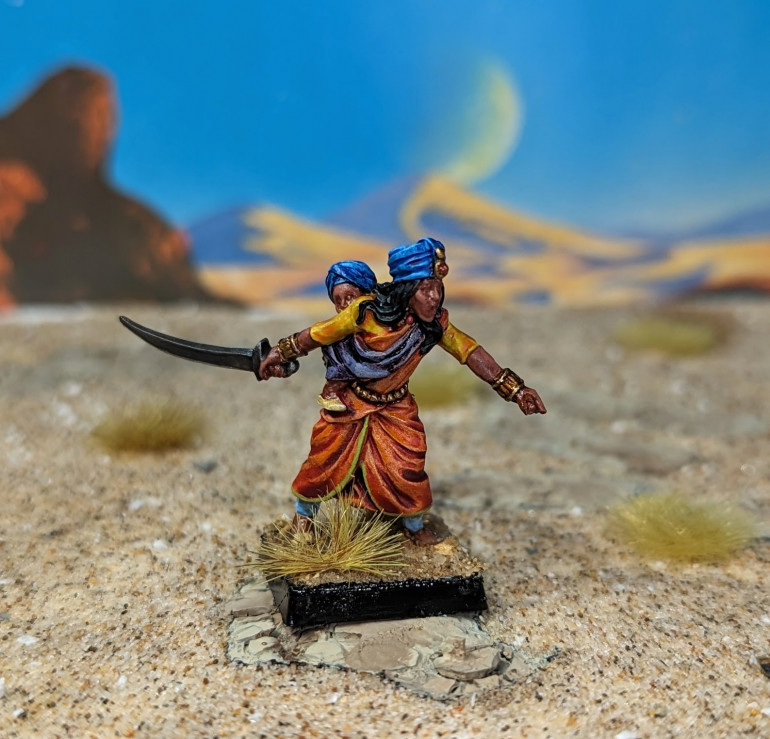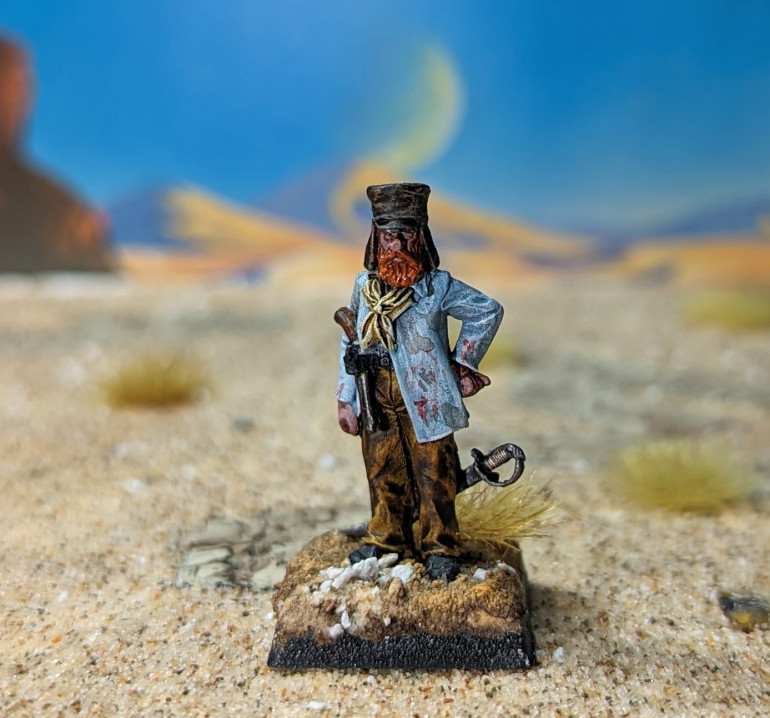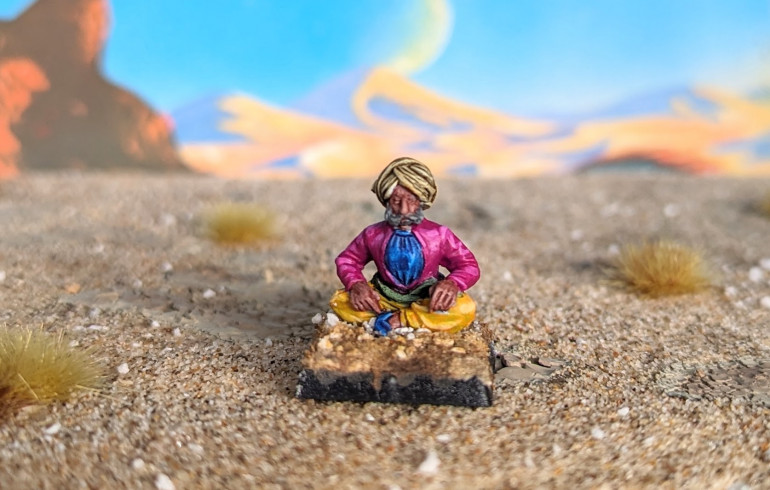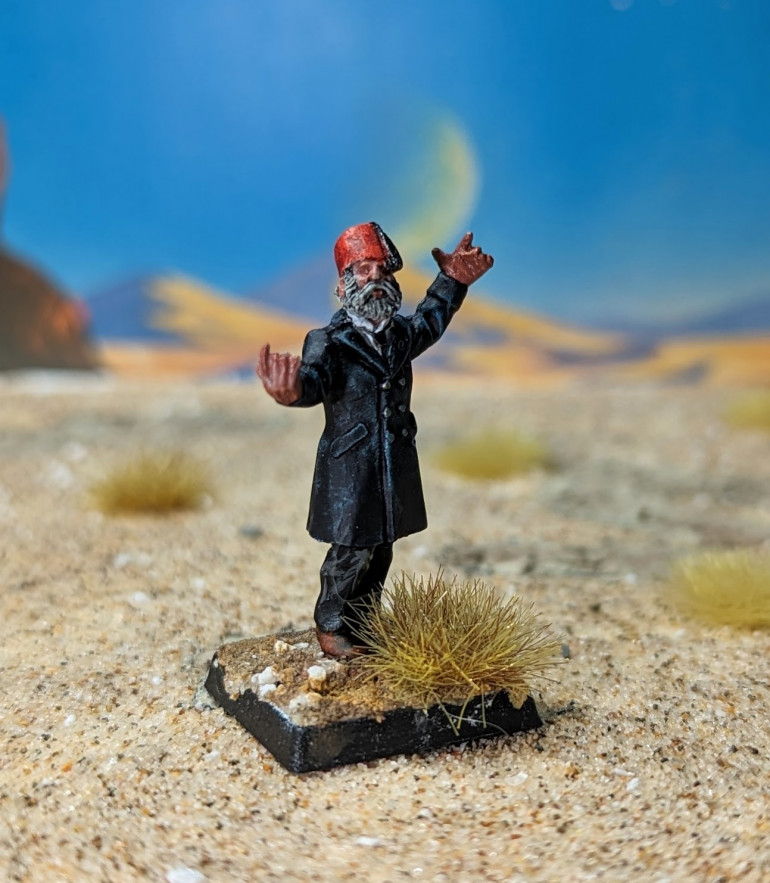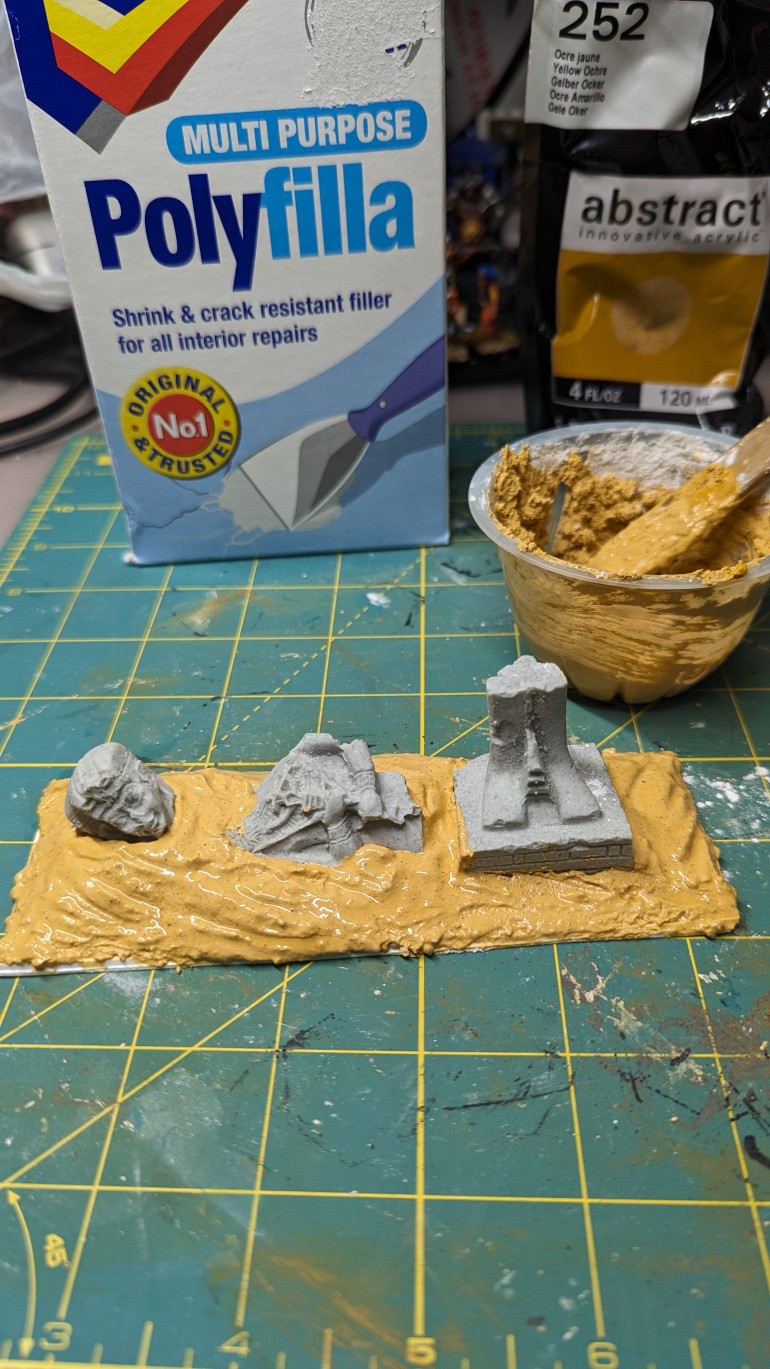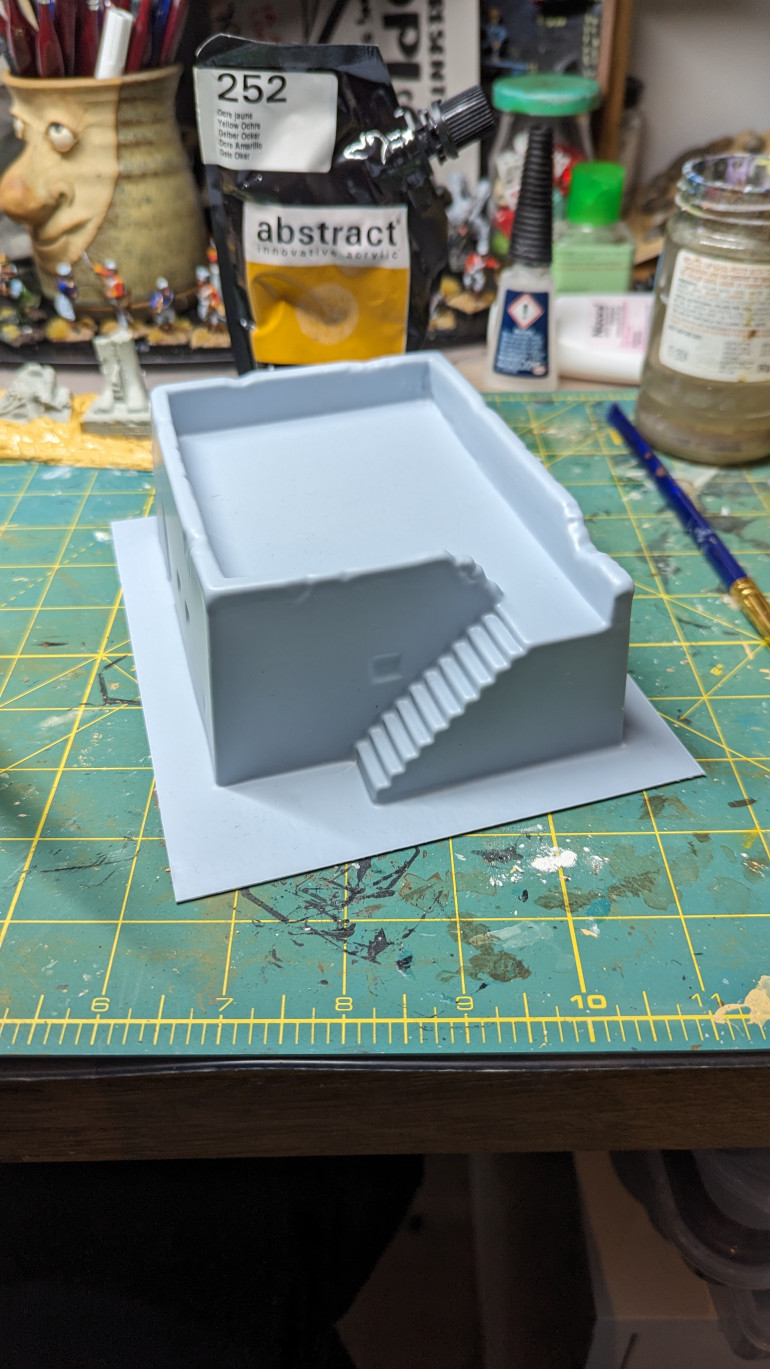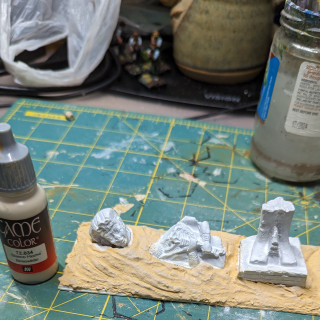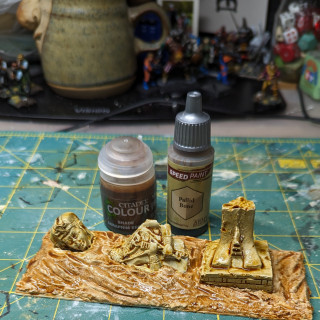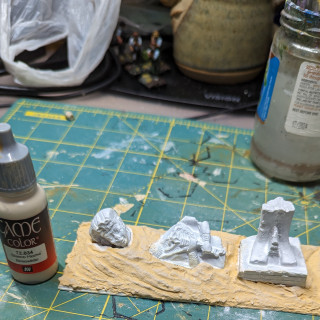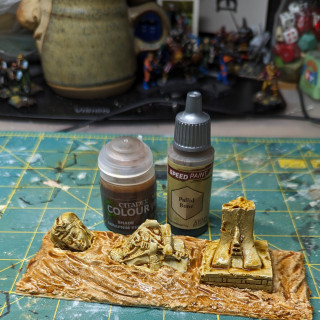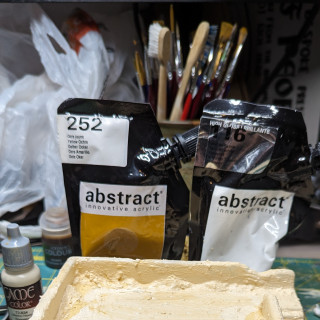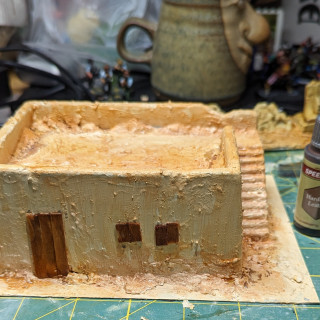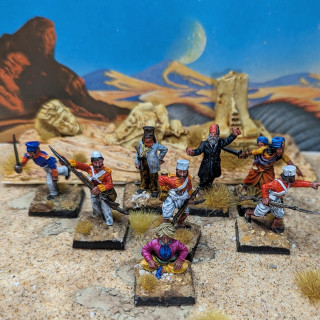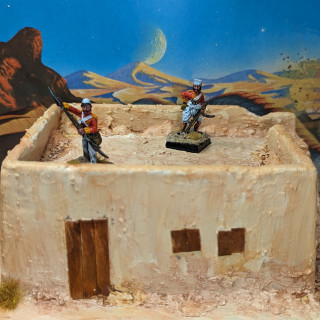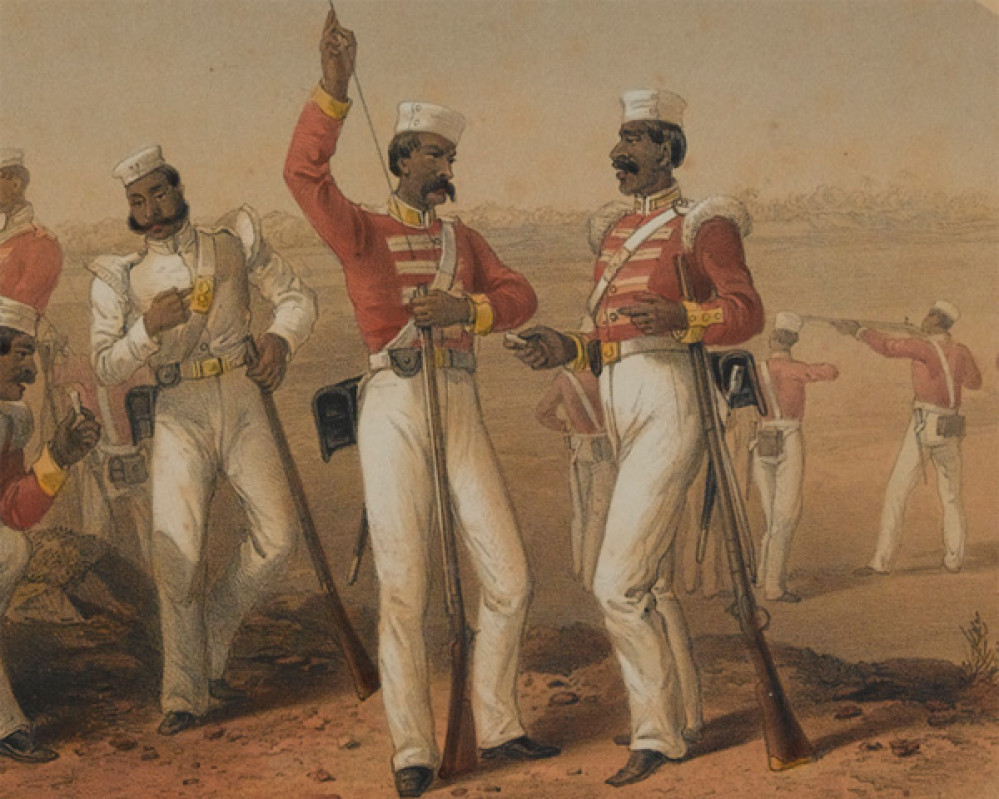
Sepoys on the Sands of Egypt : An East India Company Unit for Silver Bayonet
Recommendations: 189
About the Project
In short : I wanted to paint a unit for "The Silver Bayonet: Egypt" made up of troops from The East India company. In Long... After painting a stereotyped 'big muscled Sikh' miniature, I wondered why that trope existed and wanted to paint some other, less comic book miniatures representing people from India. I guess it's important for me as my wife is a British Asian and I think our kids should see me playing with tiny fighting men that represent both sides of their heritage.
Related Game: The Silver Bayonet
Related Genre: Horror
This Project is Completed
Research
Googling for East India Company troops quickly led me to a page that listed Egypt in 1801 as one of the places that soldiers of the East India Company fought. I never knew that, and with the forthcoming release of ‘The Silver Bayonet: Egypt” my creative juices started flowing.
The thing that really launched me on this quest was reading the following :
“Although sepoys had served outside India before 1801, their participation in a campaign on the very borders of Europe was considered historic. It was, in the words of one British officer ‘a singular event in the Annals of warfare…’ ”
Fantastic: let’s look for miniatures.
My first stop was Perry Miniatures. I was very pleased to see that of course they have ‘Bombay Sepoy’ and ‘Bombay Grenadiers’ in their Napoleonic range (with ‘Corsican Rangers’ on the same page – Googling them is an interesting read). Unfortunately the basic troopers in both ranges aren’t in dynamic poses, simply marching in formation, which would look rather dull in a game of Silver Bayonet. The command units for both are in more interesting poses but they clearly are from Britain rather than India.
I couldn’t find Indian troops in any other Napoleonic ranges, so started widening my search. Although it’s 50 odd years later there are plenty of options available for The Indian Mutiny. I’m no rivet counter (or I suppose button counter in this case) so these will do fine.
After spending many happy evenings looking through various companies ranges, I decided to go for 3 packs of figures from Empress Miniatures: ‘Mutineer Command’, ‘Quatermaster Group’ and ‘Sepoys in tunics firing’ which will give me a good range of characters and interesting looking troops. I’ll show them in the next post
Miniatures
Sorry for the blurred photos. I’ve added links to the relevant pages on the Empress Miniatures website so you can see them in all their bare metal glory if you want to.
The Mutineer Command pack is full of potential soldier types. The two mini’s with swords are clearly officers or junior officers. The soldier holding the musket and pointing would work as an infantryman or perhaps a grenadier. I’m not sure if there any rules for bugles in Silver Bayonet, so perhaps that figure is the least useful? He could be an officer of course.
There’s more character models in the Quatermaster Group. In my head the guy sitting down is clearly a religious or academic type; perhaps a Supernatural Investigator or Champion of Faith. The chap with a pistol tucked into his belt is screaming ‘Doctor’ at me. The chap casually holding a musket and with a sword could come in useful for a Sapper. That leaves the miniature without weapons or a top – I’ll have to think about him.
All of the figures in this pack (Sepoys in Tunics Firing) are useful as infantrymen or Grenadiers. All individual in interesting poses, they’ll make a fine core to any unit. I’ll say one thing though : I’d be amazed if those bayonets last very long knowing what I do about my ability to drop miniatures on the floor (usually the minute I’ve finished painting them).
Uniform research
As I previously mentioned, I’m not a button counter. So I’m not looking for exact colour schemes to copy, but rather a general flavour of the kind of thing I should be aiming for. A push in the right direction, if you will, and perhaps noting some things to avoid.
I’ll post the results of my limited research (Google image search for ‘East India Company Uniforms’) in date order here, the earliest first.
This first one was a bit of a surprise for me: a blue coat. My limit knowledge of the period led me to believe that blue was the domain for the French army. However apparently that’s the uniform of an artillery private (or golandaz) in the Bengal Army.The other two are pretty much as expected : a red coat with coloured trim over white shirt and trousers.
More elaborate hats than my figures have too.
This one, from 1815, continues to confirm my generalisation. Red coat (check), white trousers (check). Blue hats – that’s something to think about.
Ah, alright – seems like anything goes once you get into uniforms for specialisation beyond your basic infantryman.
From left to right (taken from here) we’ve got:
- Madras Horse Artillery
- Madras Light Cavalry
- Madras Rifle Corps
- Madras Pioneers
- Madras Native Infantry
- Foot Artillery.
This is nice for me as I reckon I can do just about any colour scheme that I fancy. Still mainly white trousers though. I must remember that.
Blue trouser now! Anything goes and the ‘rule of cool’ will work for me.
OK, time to pick up a brush…
Three Sepoys.
Paints used:
Tunics: Valeijo game colour Blood Red, highlighted with Orange Fire from the same range.
Yellow Trim: Valeijo Sun Yellow with a Citadel contrast Iyanden Yellow wash.
Trousers and other white parts : Citadel contrast Apothecary White highlighted with Pro Acryl Bold Titanium White.
Skin: Army Painter Tiger’s Eye Skin, mixed with AP Dorado Skin to highlight.
Hair and boots: Citadel contrast Black Templar
Leather: Citadel contrast Snakebite Leather
Muskets: Citadel contrast Wyldwood and Citadel base Leadbelcher.
An officer and a doctor
In addition to the paints used for the sepoys in the last post, I’ve used Pro Acryl transparent blue for the officers jacket.
The doctor has a completely different palette. I’ve used Citadel Contrast Apothecary White, mixed with a tiny bit of ancient citadel electric blue. His hat is contrast Wyldwood, neckerchief is speedpaint Pallid Bone and trousers are speedpaint Hardened Leather. The musket is Vallejo Beasty brown which I also mixed with some Vallejo Orange Fire for his beard.
A religious man and a local.
It’s time to make this unit more ‘Silver Bayonet’ and less ‘Historical but in a weird world’ by adding some of the more specialised soldiers.
I’ve got the wonderful civilian with a turban from the Quartermaster set, and I’ve decided to add ‘The Professor‘ from Northstar’s steampunk range simply because he is wearing a fez. Yes, it’s probably a bit early for fez’s to be popular but he does add some flavour. Unfortunately I didn’t get a picture of him before painting, I was too caught up with my muse.
So, the new paints that I’ve used here t are some speedpaint (version 1) : Camo Cloak, Highlord Blue and Pallid Bone; Vallejo Sun Yellow and another survivor from the 1980s Citadel Imperial Purple.
I’ll use this miniature as a Supernatural Investigator, or possibly a Champion of Faith. His turban is Pallid Bone, shirt and shoes are Highlord Blue, all one coat of speed paint. The jacket is Imperial Purple highlighted with a mix of that and a touch of white. Trousers are Sun Yellow again highlighted with a touch of white to the mix. Finally his belt is camo cloak.
Skin is the same mix as the sepoys below, with a grey moustache.
A very quick and satisfying miniature to paint. Skin as per the other figures, grey hair again. Blood red speed paint for the fez, Snakebite leather for the shoes, white shirt, Black templar for everything else. Oh… I picked out the buttons with some leadbelcher.
I had decided that was going to be it, but running through the recruitment points in the books I’m short at least one soldier. So, it’s back to the unpainted box. The question is do I bulk out my unit with a few more infantrymen or go for one more expensive (special) soldier. Looking at playthroughs (honestly have a look at Gerry and Shay Che’s “Let’s play” for a good introduction to the game) most people seem to have 7 or 8 maximum per unit so maybe a specialist is the way to go.
Final Miniatures
Shortly after deciding I needed another character figure, I noticed the ‘Flash Harry Revisted’ minitature from Northstar and thought he might do as a token white officer in the squad. It was in a range from the Northstar website that I’d never noticed before (‘Giants in Miniature‘ ) so I had a poke around. As luck would have it they also had a kick ass Indian woman with a sword which would work very well as my final member of the team: ‘Lakshmi Bai‘
When she turned up she was a little bigger than the Empress Miniatures that made up the rest of the unit, but by removing her base with an old pair of snippers and some files, that’s a lot less noticeable.
I didn’t get a photo of the paints that I used for this, but it’s mainly speed and contrast paints, which work well for all the folds in her sari.
I also painted the final four sepoys that came with my order from Empress Miniatures, so I’d have some backups for the inevitable casualties that will occur during a Silver Bayonet Campaign. This also saw the first predicted loss of a bayonet from one miniature. I found it once and super glued it back on, but it soon disappeared for good. Luckily this mini is reaching into his cartridge bag to reload, so it looks like he’s fumbling to find his bayonet, particularly if you stand him next to the miniature who is actually fixing his bayonet to his musket.
Next I’ve written the background for all of the unit.
I’ll put that in my next post.
Final Miniatures
Shortly after deciding I needed another character figure, I noticed the ‘Flash Harry Revisted’ minitature from Northstar and thought he might do as a token white officer in the squad. It was in a range from the Northstar website that I’d never noticed before (‘Giants in Miniature‘ ) so I had a poke around. As luck would have it they also had a kick ass Indian woman with a sword which would work very well as my final member of the team: ‘Lakshmi Bai‘
When she turned up she was a little bigger than the Empress Miniatures that made up the rest of the unit, but by removing her base with an old pair of snippers and some files, that’s a lot less noticeable.
I didn’t get a photo of the paints that I used for this, but it’s mainly speed and contrast paints, which work well for all the folds in her sari.
I also painted the final four sepoys that came with my order from Empress Miniatures, so I’d have some backups for the inevitable casualties that will occur during a Silver Bayonet Campaign. This also saw the first predicted loss of a bayonet from one miniature. I found it once and super glued it back on, but it soon disappeared for good. Luckily this mini is reaching into his cartridge bag to reload, so it looks like he’s fumbling to find his bayonet, particularly if you stand him next to the miniature who is actually fixing his bayonet to his musket.
Next I’ve written the background for all of the unit.
I’ll put that in my next post.
Unit and Background
Subedar Gaekwad (officer).
The wayward, youngest son of a Maratha had few prospects at home and so joined the East India Company not only to make something of himself, but also with an eye on learning the military tactics of those who could one day threaten the supremacy of his family. When he heard of the campaign in Egypt and the chance to pursue the rumored harvestmen he quickly volunteered the use of his command to his grateful superiors.
3 sepoys : 30 recruitment points.
Jiten, Hitul and Kavish are boyhood friends who grew up on the streets of Mumbai and joined the EIC as the pay on offer was better than any other they could get. They weren’t expecting to be sent to Egypt, but now they’re here they intend to get some ‘supplementary income’ without catching the eye of their commanding officers.
Nishka Massi: Highlander 18 recruitment points.
Everyone knows not to mess with an Indian Aunty and Nishka Massi is no exception. Much to their embarrassment, Jiten, Hituls and Kavish’s mother’s sister somehow managed to follow them to Egypt. No one is sure how. However she has become tolerated as she’s a fierce defender of her nephews safety and has proven her use on the battlefield time and time again. Not even the burden of her own baby son can stop her from accompanying the squad into the field.
Surgeon Jain : Doctor 10 recruitment points.
Joining the East India Company as a boy, Kamlesh Jain proved himself to be a quick learner and steadily worked his way through the medical corps. A vain man Dr Jain uses henna to dye his hair red, but there’s no one better to perform an amputation while under fire.
Pandit Battula : Occultist: 20 recruitment points.
This learned holy man has been studying the epic Mahabharata for over 50 years and as such is an expert in Ancient verdic warfare and the usage of celestial weapons: the Astra and the Shastra. With great effort he can use the holy mantras to bestow any weapon with divine properties for a short time.
Unit and Backgrounds
Subedar Gaekwad (officer).
The wayward, youngest son of a Maratha had few prospects at home and so joined the East India Company not only to make something of himself, but also with an eye on learning the military tactics of those who could one day threaten the supremacy of his family. When he heard of the campaign in Egypt and the chance to pursue the rumored harvestmen he quickly volunteered the use of his command to his grateful superiors.
3 sepoys : 30 recruitment points.
Jiten, Hitul and Kavish are boyhood friends who grew up on the streets of Mumbai and joined the EIC as the pay on offer was better than any other they could get. They weren’t expecting to be sent to Egypt, but now they’re here they intend to get some ‘supplementary income’ without catching the eye of their commanding officers.
Nishka Massi: Highlander 18 recruitment points.
Everyone knows not to mess with an Indian Aunty and Nishka Massi is no exception. Much to their embarrassment, Jiten’s mother’s sister somehow managed to follow them to Egypt. No one is sure how. However she has become tolerated as she’s a fierce defender of the safety of her nephew, and all of his friends, and has proven her use on the battlefield time and time again. Not even the burden of her own baby son can stop her from accompanying the squad into the field.
Surgeon Jain : Doctor 10 recruitment points.
Joining the East India Company as a boy, Kamlesh Jain proved himself to be a quick learner and steadily worked his way through the medical corps. A vain man Dr Jain uses henna to dye his hair red, but there’s no one better to perform an amputation while under fire.
Pandit Battula : Occultist: 20 recruitment points.
This learned holy man has been studying the epic Mahabharata for over 50 years and as such is an expert in Ancient verdic warfare and the usage of celestial weapons: the Astra and the Shastra. With great effort he can use the holy mantras to bestow any weapon with divine properties for a short time.
Supernatural investigator: 22 recruitment points.
Ask around the Khan el-Khalili Souk in Cairo for somewhere to buy relics from the tombs of the Pharaohs and you’ll be directed to the small shop in a quiet alleyway. But the owner, Ameer Tadros, does not simply deal in fake trinkets for the unwary. In the back room there are crumbling papyrus scrolls containing the knowledge of the ancients. Ameer has read them all and is an invaluable ally in the fight against the harvestmen.
Some Terrain - part 1: preparation.
Before I’d finished painting the miniatures I was looking around at terrain and scatter terrain. The first thing that I found was this broken statue from Fenris. It’s a lovely set of bits which could be painted up and literally scattered onto a tabletop, but I decided that I wanted to keep them together.
Step one was to glue the base part of the statue to some plasticard, with a wedge of cork underneath to level it a bit. Next I mixed up some polyfilla with a bit of sand, grit and craft store acrylic paint.
I slathered this mixture onto the rest the pasticard base and tried to sculpt it into sand dune like shapes. For this I used a lot of water on a sculpting tool to add furrows and undulations and smooth the surface, which did have me wondering why I bothered to add the sand and grit?
I then got the remaining two pieces of the statue and pushed them into the polyfilla in the hopes that it would look like they’d been swallowed up by the wind blown sand.
I had quite a bit of the polyfilla mixture left, so I quickly got the ‘North African Desert Building‘ I’d bought from Amera mouldings.
I decided to give this a go as you can’t go wrong for £4 can you? I know a Renedra kit would be stronger and I could do a whole table with different Fogou adobe buildings, but I was intrigued by these.
I watered down my polyfilla mix and daubed it onto the building with an old brush. In hindsight this may have been a mistake, and I should’ve primed the model first as my mix hasn’t bonded properly at all.
Some Terrain - part 2: painting
If you’re reading this : come back in half an hour.
This is my 3rd attempt at posting this entry, so I’m going for a multiple save approach. I’ll delete this first block of text when I’m done.
—–
The craft store paint in the polyfilla mix took care of the base colour for my sand burying the broken statue, so the first stage of painting proper was a dry brush of Vallejo Bone White. I then used some watered down Citadel Seraphim Sepia to wash over the sand, and some Army Painter Pallid Bone to paint the parts of the broken statue.
Some Terrain - part 2: painting
The craft store paint mixed into the polyfilla had taken care of the base color of the ‘sand’, so the fist stage proper was to drybrush some vallejo Bone White. I then added a wash of slightly diluted citadel Seraphim Sepia and used army painter Pallid Bone to paint the pieces of broken statue.
I also started to must Bone White on the building, but I quickly realised that this was a fine way to use up a whole bottle of paint very quickly so I switched to craft store acrylics again, mixing up an approximate match from the colours that I had available.
At this point I realised that the rather dull detailing of the doors and windows would be lost in a thick layer of paint, so I snipped a strip of bamboo (a candle splint rather than a coffee stirrer) into lengths and glued them over the ones on the model. I then washed everything in army painter Hardened Leather speedpaint: diluted for the building and undiluted for the doors and shutters.
A few tufts later and I’m calling them both done and ready for use.
And that’s the project done… for now.
When I get the book and play a scenario I’ll either reopen this or create a new project for a battle report. I might even get myself some Fogou adobe houses and the Renedra mud brick house for a comparison.
Right now I’m going to open a Fry’s Turkish Delight, pour myself a glass of Indian whisky and bask in the warm glow of my golden button. Thanks again for that, cheers.





























